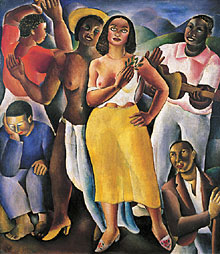
Emiliano Di Cavalcanti, Samba, 1925. Oil on canvas, 175 x 154 cm. Collection of Genviève and Jean Boghici, Rio de Janeiro. Photo by Fernando Chaves.

In February 1922, an event took place at the Teatro Municipal in São Paulo that altered the course of Brazilian art history: a four-day arts festival known as the Semana de arte moderna. This event was analogous in its impact to New York’s Armory Show of 1913. In both cases, the public had the opportunity to see new approaches to visual expression, including works that shocked conservative visitors. Much of what constituted Brazilian Modernism had its roots in such international phenomena as Expressionism, Futurism, and Cubism. However, artists such as Tarsila do Amaral, Victor Brecheret, Emiliano Di Cavalcanti, Anita Malfatti, Vicento do Rêgo Monteiro, and Lasar Segall searched for ways to create a unique “Brazilianness” in their art.
At the time of Semana de arte moderna, Tarsila, the best-known Brazilian artist of the 1920s, was in Paris studying with friends and mentors such as Constantin Brancusi, Fernand Léger, and André Lhote. The period from 1923 to 1930, the most productive span in her long career, may be divided into two phases: the Pau Brasil period of 1924–27 and the Antropofagia period of 1928–29. In the first of these, named for brazilwood, the country's first export product, Tarsila created icons of Brazilian nationalism and images of rural life. During the second, named after the 1928 Manifesto anthropófago by Oswald de Andrade, she produced work with Surrealist overtones. She later turned to Social Realism as did Cândido Portinari, who impressed both Brazilian and North American audiences with his images of rural workers. His most famous of these, Coffee (1935), depicts the arduous life of agricultural workers in the interior of Brazil.
Alberto da Veiga Guignard is best remembered for his dreamy landscapes of the Baroque cities and town of Minas Gerais. While Guignard's paintings are not directly connected to Surrealism (which had many proponents in Latin America in the 1930s and 1940s), they nonetheless have an oneiric quality that removes them from the realm of the everyday. The biomorphic sculptures of Maria Martins is related to the imagery of artists like Jean Arp, Joan Miró, and Yves Tanguy. Martins was an intimate friend of Marcel Duchamp, and their relationship shaped the direction of both artists’ work.
—Edward J. Sullivan